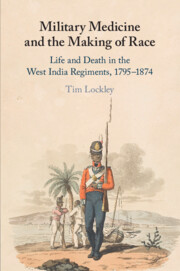Book contents
- Military Medicine and the Making of Race
- Military Medicine and the Making of Race
- Copyright page
- Dedication
- Contents
- Figures and Tables
- Acknowledgements
- Introduction
- 1 Medical Necessity and the Founding of the West India Regiments
- 2 The Ideal Soldier
- 3 The Use and Abuse of the Black Soldier
- 4 Statistics and the Reinterpretation of Black Bodies
- 5 Dehumanising the Black Soldier
- 6 Damage Done: The Asante Campaigns
- Conclusion
- Bibliography
- Index
3 - The Use and Abuse of the Black Soldier
Published online by Cambridge University Press: 13 March 2020
- Military Medicine and the Making of Race
- Military Medicine and the Making of Race
- Copyright page
- Dedication
- Contents
- Figures and Tables
- Acknowledgements
- Introduction
- 1 Medical Necessity and the Founding of the West India Regiments
- 2 The Ideal Soldier
- 3 The Use and Abuse of the Black Soldier
- 4 Statistics and the Reinterpretation of Black Bodies
- 5 Dehumanising the Black Soldier
- 6 Damage Done: The Asante Campaigns
- Conclusion
- Bibliography
- Index
Summary
Accepting that white and black soldiers were physically different meant that army commanders could treat them differently too. White soldiers were housed in the newest barracks and healthiest locations precisely because it was thought that black soldiers preferred, and indeed would thrive in, places too sickly for whites. If economies in diet or clothing needed to be made, it was generally thought that West India Regiment soldiers enjoyed living off the land and could easily cope without army rations, or complete uniforms. But it was the perceived ability of black soldiers to labour in tropical conditions that caused the most significant problems. Some unscrupulous commanders were willing to use the men as forced labour. This was not uncontested, some army commanders warned against it, and the men of the 8th West India Regiment mutinied in Dominica in 1802 as a direct result of being used, as they saw it, as slaves. The blame for this mutiny was eventually laid at the feet of abusive commanders, but differential treatment was clearly shaped by an understanding that white and black bodies were not the same.
- Type
- Chapter
- Information
- Military Medicine and the Making of RaceLife and Death in the West India Regiments, 1795–1874, pp. 84 - 112Publisher: Cambridge University PressPrint publication year: 2020

